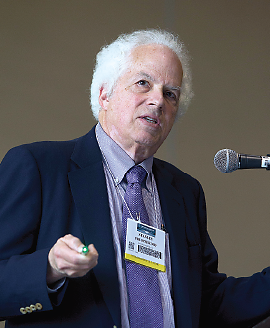Prions May Be at Root of Several Brain Diseases
Abstract
Nobel Prize–winner Stanley Prusiner, M.D, explains the relationship between prions and human neurodegenerative disorders.
Prions, those tiny bits of rogue protein that cause mad-cow disease, also may be implicated in human illnesses of the brain, said Stanley Prusiner, M.D., in a lecture at APA’s 2013 annual meeting in San Francisco in May.

Prions are important precursors of human neurological diseases, their discoverer, Stanley Prusiner, M.D., explains at APA’s annual meeting.
Prusiner discovered prions, the nonliving proteins that cause scrapie in sheep, bovine spongiform encephalopathy (“mad cow”) in cattle, chronic wasting disease (CWD) in elk, and Creutzfeldt-Jacob disease in humans. Now, he adds Parkinson’s disease, Alzheimer’s disease, frontotemporal dementia, and possibly ALS to that list.
Prions are composed of host-encoded proteins that adopt a self-propagating, alternative conformation, said Prusiner, a professor of neurology and director of the Institute for Neurodegenerative Diseases at the University of California, San Francisco. Prions replicate as the normal isoform of the prion protein (PrPC) is converted to the isoform that causes disease (PrPSc).
Prusiner’s groundbreaking work was met by some initial skepticism, but was ultimately recognized with the Nobel Prize in Physiology or Medicine in 1997.
Public attention has focused on infectious origins of prion diseases, especially among those who ingest infected meat. However, infection rarely occurs except for CWD prions, which can infect more than 90 percent of cervids in herds, he said.
“Over 99 percent of prion disease cases are inherited or sporadic,” he said. “In Alzheimer’s disease, frontotemporal dementias, Parkinson’s disease, and Creutzfeldt-Jacob disease, different proteins become prions, namely, amyloid-β, tau, α-synuclein, and PrP.”
Furthermore, these diseases are only 10 percent to 20 percent heritable, suggesting to Prusiner that such late-onset disorders represent the accumulation of damaging proteins over time, moving slowly from one neuron to the next.
“Different proteins differentiate into different diseases,” he explained. “This explains how they can be variously infectious, inherited, posttraumatic, or sporadic.”
One possible trigger for the cascade that leads to these disorders is head trauma, said Prusiner. Many different causes of brain injury provoke the neurofibrillary tangles of tau protein seen on autopsy, including trauma.
Recent suicides by former National Football League players highlight the effects of repeated blows to the head over years of play, he suggested.
“Their lives began to fall apart in their 30s, 40s, or 50s as they exhibited changes in personality, behavior, executive function, and language,” he said. In these posttraumatic frontotemporal dementia cases, tangles accumulate in the frontal lobes, producing profound neuropsychiatric illness.
Such cases are hard to diagnose. Many patients see a psychiatrist first, but later are referred to neurologists.
The chronic traumatic encephalopathy in athletes caused by repeated head trauma is a primary tauopathy, while Alzheimer’s disease is a secondary tauopathy initiated by amyloid-β prions, he explained.
He noted that the military medical system has seen a steady increase in traumatic brain injuries since 2005, one paralleled by a rise in hospital-bed days for substance abuse, anxiety, mood, and adjustment disorders as well as suicidal ideation.
In the search for treatments, Prusiner and others have been testing several compounds on cells and in mice. Initially positive tests of these drugs extended the lives of mice that overexpressed certain chimeric human/mouse prions. However, drug resistance developed, producing conformational mutations that resulted in a new prion strain independent of DNA and RNA, said Prusiner.
“Either the drug selects for a subset of conformers or the drug is actually changing the conformation,” he said. “It’s not clear which.”
This “conformational mutagenesis” suggests that a combination of drugs with different mechanisms of action will probably be needed to attack prion disease at different points in the conversion process, since neuronal function will be unlikely to be restored once it is lost, he said.
“There are three possible points for intervention: decreasing precursor proteins, inhibiting their conversion, or increasing their clearance,” he said. “Developing drugs that don’t attack the headwaters of the process is a mistake.” ■



